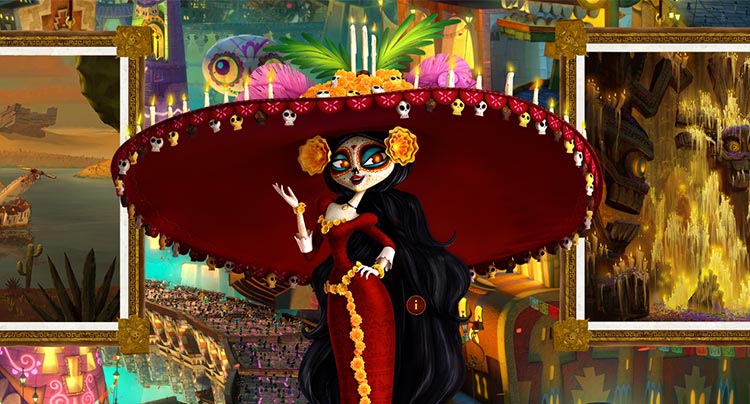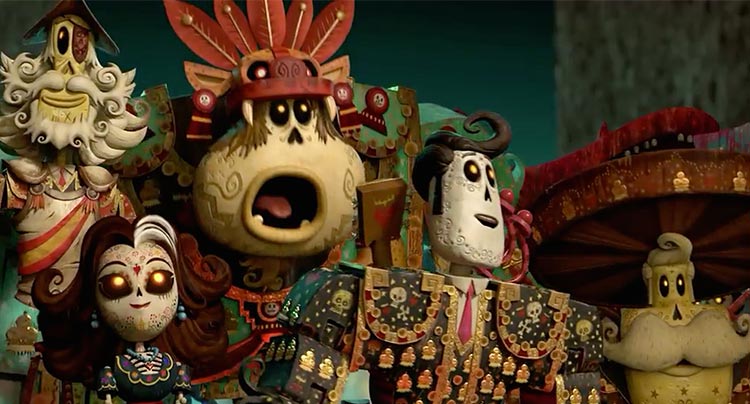
Relying too much on it's stimulating imagery this children's tale offers little innovation.

Relying too much on it's stimulating imagery this children's tale offers little innovation.
It’s a given that children’s movies will fall into certain plot paths. Characters and story devices are often obvious; themes and lessons are overly sentimental. Given the right mix of well-placed maturity throughout, this doesn’t have to mean a children’s movie feels “dumb.” Pixar has been doing it right for years. Dreamworks has started catching on with How to Train Your Dragon. Twentieth Century Fox has mostly stuck to animal films, and Reel FX Animation has hardly produced anything, but the two companies are certainly branching out with their latest, The Book of Life. Full of some vibrant and excellent animation, fraught with detail, the film gives some much overdue appreciation and attention to Latino culture. But the film is limited in its innovation, leaning heavily on its imagery while being weighed down by stock children’s cartoon characters with Mexican accents (though not even consistently).
Produced by Guillermo del Toro and directed by feature first-timer Jorge Gutierrez, The Book of Life tells the story of La Muerte (Kate del Castillo) and Xibalba (Ron Perlman), the rulers of the Land of the Remembered and the Land of the Forgotten respectively, who make a wager regarding three children: empathetic and quick-witted Maria (Zoe Saldana), musically inclined Manolo (Diego Luna), and the heroic and orphaned Joaquin (Channing Tatum). Separated at a young age when Maria is sent off to boarding school in Spain, Manolo grows into a sentimental musician forced into the family business of bullfighting, while Joaquin — aided by a magical pin the sneaky Xibalba gave him ensuring he can’t be hurt — becomes a prized soldier like his general father before him. Maria returns all grown up and the wager for which of the men will win Maria begins. But Xibalba doesn’t play fair, and when Maria begins to fall for the crooning Manolo (women are so predictable) he sends his venomous snake to do away with Manolo. This sends Manolo on an adventure among the dead, determined to reunite with Maria.
In a somewhat telling parallel, the film’s story is told by a museum tour guide to a group of unruly white kids. This isn’t the only way Mexican director Gutierrez panders, working in many recognizable Mexican elements (churros, moustaches, mariachi) almost as if to soften the heavier subject of the Mexican view of death to white audiences. It wouldn’t be so bad except that the script meanders and fails in its likability to make up for such things.

The love triangle is generic, with very little motivation behind the men’s competition other than their view of Maria as a muse (Manolo) or a prize (Joaquin). And while she asserts herself, Maria’s feminist stance is barebones and rather moot in the face of almost no character development. Instead generic themes erupt as if trying to fill some sort of quota — teamwork wins, love prevails, good conquers evil, death is not the end, friendship is greater than or equal to love, etc. They’re all there, but none of them really stick. And when about 8 new characters are introduced in the second half of the film, there is just too much going on for there to be real connectedness to anyone.
The puppet style of the characters, with their hinged limbs, is an interesting animation choice, but doesn’t necessarily tie in to Día de Muertos directly. Overall the abundance of detail can be somewhat feverish and points to a director whose background lies primarily within animation. The sunset coloring is at first striking, and then numbing. It is undeniably skillful, but some restraint may have made it that much more impressive.
The Book of Life is overstimulating, holding all its energy in its colors and the constant action of its characters, but when broken down, while everyone is doing so much, there are almost no moments of originality or chances for emotional affinity. I can’t decide if Gutierrez and co-writer Douglas Langdale underestimate children’s ability to notice when clichés are being thrown at them, or if there was some sort of self-doubt that accounts for their over saturation of trite techniques in the film. Given so much to look at and experience, the film ends up offering very little, even when it seems obvious real talent lies behind the effort.